Vol 1. Issue 4. September 2023
Mercury in the Tropics – a Hidden Risk
By Sarah Dodgin, Ecological Analyist, BRI
Neon green hoods, turquoise bellies, ornate crowns—Neotropical birds come in all shapes, sizes, and colors. Combined with unique patterns, textures, and song, they either blend in or stand out in thick jungles filled with hundreds of other species competing for the same or similar resources.
When the first European explorers discovered Central and South America and the West Indies, they called this land the New World Tropics, a region known today as the Neotropics. Here in the dense rain forests of the Amazon, you would not suspect that many of the vibrant and charismatic birds that inhabit these remote areas are regularly exposed to sublethal amounts of mercury. In this seemingly pristine part of the world, how does mercury find its way into these birds?
From affordable common goods to expensive investments, so many of our daily decisions seem inconsequential. But as our awareness grows, we are forced to think before we make a transaction and to ask ourselves a few questions: Where did this product come from? What industry is this tied to? And who, be it person or animal, is paying the price for my purchase?
Many people have some understanding of the ethical dilemma associated with diamond mining. Conflict free, responsibly mined, and ethically sourced are all things we are urged to deliberate when making a selection of this precious gem. But what about gold? It turns out there are similar social and environmental considerations when picking out a pair of hoops. According to the World Gold Council and the World Bank, 15 to 20 million people make artisanal small-scale gold mining (ASGM) their primary source of income. Unlike large-scale gold mining, ASGM takes place outside of formal legal and economic structures, and although the operation itself is small in scale, its prevalence around the world looms large. In addition to labor rights and safety concerns for miners, another metal involved in the gold extraction process poses a threat to entire ecosystems.
Mercury, a dense and silvery fluid, is the only metal in a liquid state at standard room temperature and pressure. Although mercury naturally occurs in small quantities in its elemental form and is usually contained deep in the Earth’s crust, the United Nations Environment Programme found that industrial activities such as ASGM, fossil fuel combustion, and waste incineration increase the amount of mercury released into the environment. Furthermore, mercury rapidly becomes a global issue because of its ability to mobilize far from the source of emission, contaminating soils, waterways, and the atmosphere. Particularly deleterious is the biomagnification (the ability for toxin levels to increase to successively higher concentrations in a food web) property of mercury when transformed to its organic form methylmercury. If exposed under the right conditions, mammals, birds, and fish suffer from behavioral, immunological, neurological, physiological, and reproductive impairment. Yet, there is a lack of Information on how mercury contamination occurs in the Neotropics, and the prevalence of mercury in birds across this region.
To remedy this important knowledge gap, Chris Sayers, an associate research biologist at BRI and a Ph.D. student at UCLA, embarked on a mission to collaborate with more than 30 researchers from ten organizations throughout the Americas, including BRI. By examining 13 years of data comprising more than 2,000 samples from 322 neotropical bird species, documenting bird blood and feather samples from every site and habitat type surveyed in eight countries across Central America, South America, and the West Indies. “It wasn’t surprising to find these samples contained some amount of mercury because mercury is a naturally occurring, persistent, and globally distributed element,” says Sayers. “What is startling, however, is the elevated concentrations that we detected.”
Beyond identifying mercury-emitting sources and mercury contamination hotspots through blood and feather sampling, determining the risk of mercury exposure in Neotropical birds was the study’s most notable outcome. Sayers found that risk was most strongly determined by four variables: diet, habitat, proximity to ASGM, and seasonal rainfall.
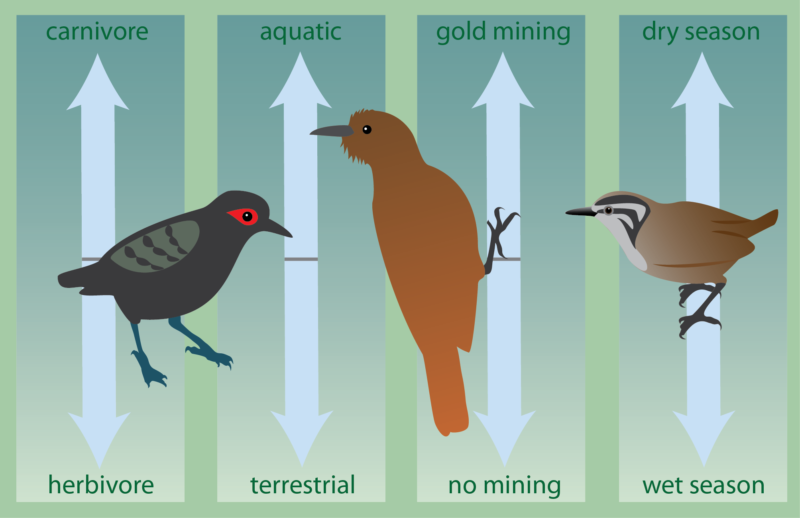
Birds are valuable bioindicators to help researchers understand how increasing mercury pollution throughout the global tropics impacts wildlife, ecosystem, and human health. This graphic illustrates the cumulative factors that contribute to higher mercury exposure. For example, carnivores that live in aquatic habitats near ASGM activities are more likely to have high levels of mercury.
Without the cooperation of dozens of researchers to create a database of thousands of mercury concentrations, these findings would not be possible. That’s why BRI’s Tropical Research for Avian Conservation and Ecotoxicology (TRACE) Initiative was created. TRACE serves as an inclusive and equitable data-sharing platform, documenting mercury exposure in birds. More broadly, TRACE gives scientists the ability to uncover the greater implications of mercury pollution to global biodiversity loss and human health. Through continued research and international collaboration, birds will remain as bioindicators of mercury pollution to create positive impacts for communities threatened by exposure globally.
A small percentage of Neotropical birds are migratory. You might not realize it, but chances are you have seen, or know the names of some species. Common birds you may find in your backyard during the summer include warblers, swallows, vireos, and hummingbirds. This time of year, while we are watching the snow fall, they are keeping warm in countries such as Brazil and Costa Rica. But in order to keep them coming back year after year, regulators must curb mercury pollution in all industries, especially within artisanal small-scale gold mining.
As consumers, it is our job to decide where our values lie this holiday season (and all year long). Will global biodiversity be one of them?
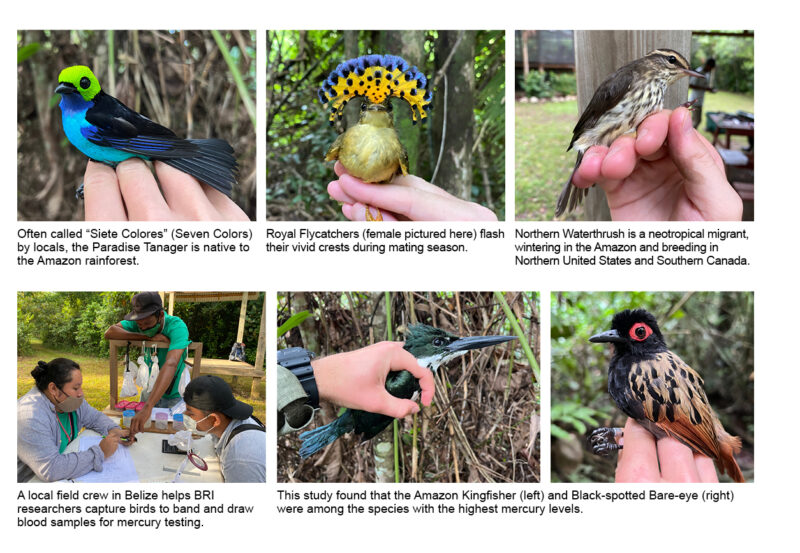
The Tropical Research for Avian Conservation and Ecotoxicology (TRACE) Initiative exemplifies inclusive, equitable, and international data sharing. www.briwildlife.org/trace/
________________________________________________________________________________________________
Ed Jenkins – Paving New Paths in the Wild
By Deborah McKew, BRI Communications Director
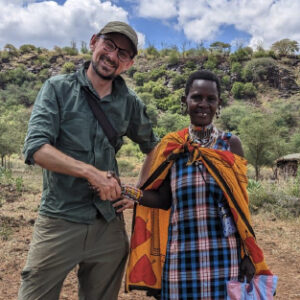 Two things stand out when you walk into Ed Jenkin’s office: he always offers a welcoming smile, and once you acknowledge him, your eyes are drawn to the beautifully curated, vibrant artwork on his walls—photographs he has taken of the many species of birds and the variety of landscapes where he has studied these birds around the globe.
Two things stand out when you walk into Ed Jenkin’s office: he always offers a welcoming smile, and once you acknowledge him, your eyes are drawn to the beautifully curated, vibrant artwork on his walls—photographs he has taken of the many species of birds and the variety of landscapes where he has studied these birds around the globe.
Ed has always been interested in birds; he can’t even remember the first time that spark ignited. “For me it was pre-memory, as just this very young child. We traveled a lot and my parents always had binoculars and bird books with them. I think it ingrained before I even remember it.”
Once he realized that watching and studying birds could be a vocation, he pursued a career in science. His interests allowed him to travel the world, studying Red-winged Fairy-wrens in Australia, researching Black-throated and Silver-throated Tits in China, and working with migratory birds in the Arava Desert of Israel.
His adventurous path led him to BRI, first as a volunteer then as a full-time avian biologist. His talents are a great asset to BRI’s River Point Bird Observatory for which he helps manage bird banding operations in Maine. It wasn’t long before his wide range of skills and experiences were requested by BRI’s other programs, for both fieldwork and data analysis.
But the travel bug kept Ed looking to pursue new opportunities. “As soon as biodiversity surveys in Africa were being discussed, I felt strongly that I should be a part of that work.”
He continued to follow progress on BRI’s various international projects, and when there was a need for someone with his expertise, he was ready. In early 2023, Ed became the International Research Lead, a position he helped define. “I’m now playing a role in many of our international projects, especially those relating to birds and bird conservation,” Ed says with that big smile of his.
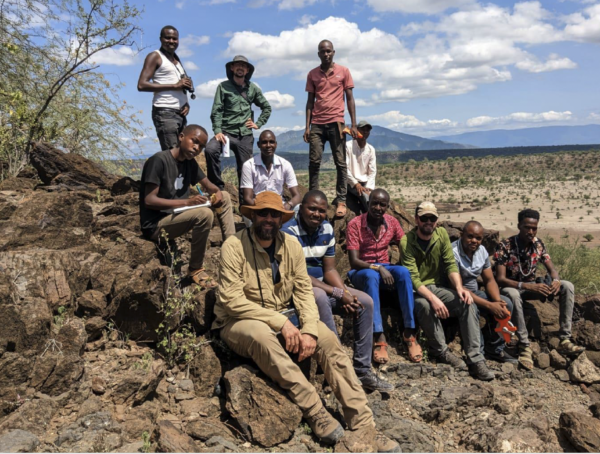
The biodiversity survey team takes a short break in the intense heat of Kenya’s Great Rift Valley. BRI scientists Chris Persico (front, left), Mark Burton (front, third from right), and Ed Jenkins (back, second from left) worked closely with Maasai wildlife experts including Denis Parmeres (middle, left) and Lankas Ole Noi (back, right) as well as local leaders and community members to conduct effective surveys in the area.
In 2023, Ed traveled to Indonesia to study the impacts of mercury on wildlife and human health, and to Kenya and Zambia to conduct biodiversity surveys as part of soil carbon sequestration projects in Africa. His responsibilities include overseeing data collection, developing study designs, refining protocols, and perhaps most importantly, building relationships with local partners.
“I spend much of my time coordinating with those groups, identifying experts in the field, trying to bring people together.” These relationships are critical to the success of BRI’s international projects. Ed’s calm demeanor and deep understanding of different cultures makes him an ideal person for this job.
Ed’s responsibilities at BRI also include roles as the director of the Wildlife Forensics Lab and co-lead of the Acoustics Lab. When he is not traveling the world, he continues to support BRI’s research centers and programs with his expertise in avian ecology. His office is getting crowded with all the new photographs from his travels—lucky for those of us who get to admire them.
Related Links:
Ed Jenkins Staff Profile
Climate Change Program
Biodiversity Research Program
River Point Bird Observatory
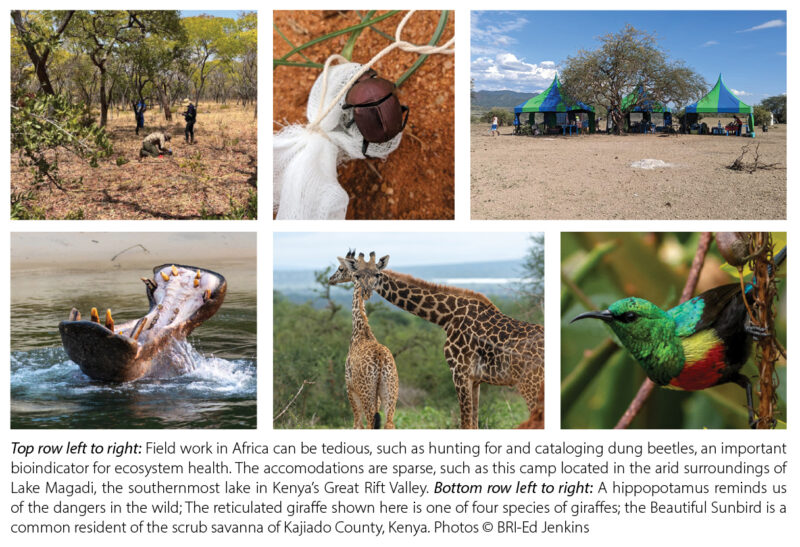
_______________________________________________________________________________________________________
Bridging the Gap – Our Caommitment
By Allison Foster, University of Maine Graduate Student
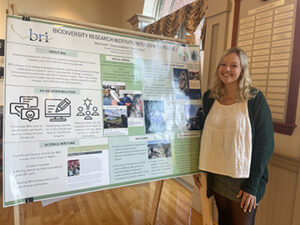 At Biodiversity Research Institute, our passion drives us to explore diverse projects across continents—from monitoring mercury levels to studying offshore wind development and tracking waterfowl movement. Yet, communicating our research extends beyond scientific journals, challenging us to make these insights not just accessible but also captivating to a wider audience.
At Biodiversity Research Institute, our passion drives us to explore diverse projects across continents—from monitoring mercury levels to studying offshore wind development and tracking waterfowl movement. Yet, communicating our research extends beyond scientific journals, challenging us to make these insights not just accessible but also captivating to a wider audience.
While peer-reviewed journals serve their purpose within the scientific community, they often miss engaging those outside our realm. This leads to a fundamental question: How do we bridge this gap? How can we ensure that our research resonates with people, sparks their curiosity, and motivates action?
For us, science communication isn’t a mere process—it’s a commitment to engage nonscientists with our scientific endeavors. It’s about conveying complex concepts effectively, embracing objectivity, transparency, and empathy.
At BRI our communication team possesses diverse skills, from writing and publishing to graphic design, all vital for effective science communication. Clear, accurate writing certainly remains a central facet, but visual mediums wield incredible power. Sharing images helps people feel more connected to what’s going on, gives a clearer vision of the work that’s being done, and enhances the relatability of the science to something that the audience cares about.
Creativity and innovation are necessary to figure out the best practices to share this information. In the past 50 years, the landscape of communication has evolved tremendously. From traditional print media and radio to the dynamic realm of social media, podcasts, and interactive platforms, the ways we share information have expanded exponentially.
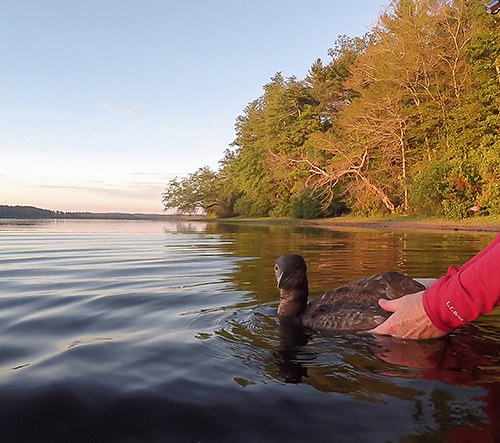 When sharing science, we must put ourselves in our audiences’ shoes. Many people have never banded loons nor have any idea of what that process entails. Narratives hold immense power in science communication. Consider a story of scientists paddling through mist-covered waters, navigating toward a loon’s nest. The team, armed with equipment and a deep reverence for nature, silently move toward the loon’s nesting area. With steady hands, they extend a gentle gesture, coaxing the loon away from its nest just for a fleeting moment. With utmost care, they gently place a metal band around the loon’s leg, witnessing its quiet return to its haven, undisturbed by the process—a poignant snapshot of our dedication to research and respect for wildlife.
When sharing science, we must put ourselves in our audiences’ shoes. Many people have never banded loons nor have any idea of what that process entails. Narratives hold immense power in science communication. Consider a story of scientists paddling through mist-covered waters, navigating toward a loon’s nest. The team, armed with equipment and a deep reverence for nature, silently move toward the loon’s nesting area. With steady hands, they extend a gentle gesture, coaxing the loon away from its nest just for a fleeting moment. With utmost care, they gently place a metal band around the loon’s leg, witnessing its quiet return to its haven, undisturbed by the process—a poignant snapshot of our dedication to research and respect for wildlife.![]()
![]()
 Science communication also helps to inform decision making, which can have significant impacts to society. By providing policymakers with actionable information, we are able to better protect our environment. BRI’s continued contributions to the Minamata Convention on Mercury are clear examples of this. Recently, at the fifth meeting of the Conference of Parties to the Minamata Convention, BRI showcased key highlights of our work through a special issue about Mercury in the Global Environment. This special issue features a synthesis of studies about mercury monitoring, providing the information in a digestible format.
Science communication also helps to inform decision making, which can have significant impacts to society. By providing policymakers with actionable information, we are able to better protect our environment. BRI’s continued contributions to the Minamata Convention on Mercury are clear examples of this. Recently, at the fifth meeting of the Conference of Parties to the Minamata Convention, BRI showcased key highlights of our work through a special issue about Mercury in the Global Environment. This special issue features a synthesis of studies about mercury monitoring, providing the information in a digestible format.
Moving forward, Anne Roe’s quote resonates deeply: “Nothing in science has any value to society if it is not communicated.” We understand that the intrinsic value of our discoveries lies in their translation—bridging the gap between knowledge and action, insights, and impact.
To see more BRI publications, visit: https://briwildlife.org/science-communications-library/
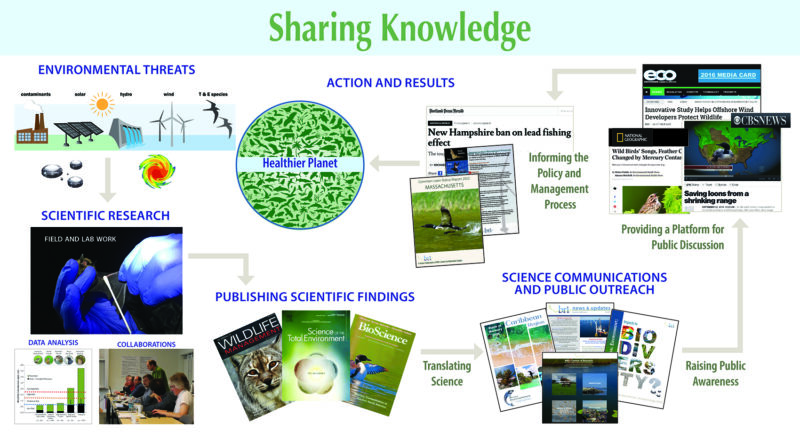
Communicating our science to a wide audience is ultimately about translating complex scientific findings and sharing the knowledge gained from collaborative research and analysis.
 This graphic shows the differences between Common Loons that breed in different regions of North America.
This graphic shows the differences between Common Loons that breed in different regions of North America.
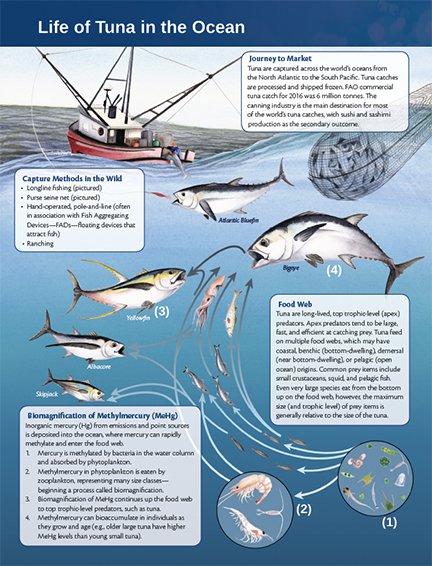
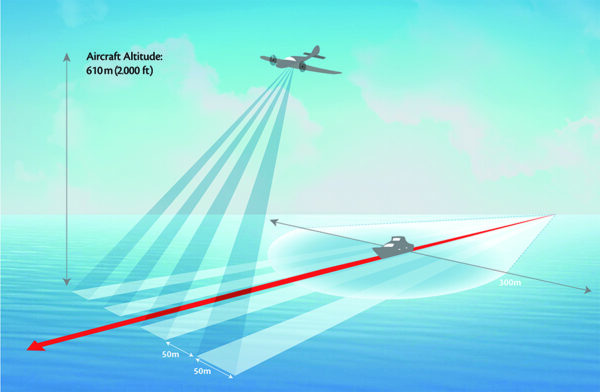
To understand the effectiveness of digital video aerial surveys, and the specific challenges faced in employing the technique in North America, we experimentally compared results from simultaneous boat and digital video aerial surveys off. This infographic shows how this study was conducted.
________________________________________________________________________________________________
Biodiversty – A Critical Concept
By Deborah McKew, BRI Communications Director
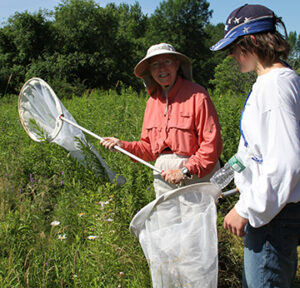 About a decade ago, BRI hosted a Bio Blitz at our River Point bird monitoring station in Falmouth, Maine. For 24 hours, researchers, citizen scientists, and nature enthusiasts walked the 41-acre conservation land to capture and catalog the variety of fauna and flora found on those acres.
About a decade ago, BRI hosted a Bio Blitz at our River Point bird monitoring station in Falmouth, Maine. For 24 hours, researchers, citizen scientists, and nature enthusiasts walked the 41-acre conservation land to capture and catalog the variety of fauna and flora found on those acres.
During the early morning start of the blitz, children and adults began to canvass the property, butterfly nets and binoculars in hand, to find every and any living thing they could—from plants, insects, reptiles, amphibians, to birds and small mammals. BRI staff set up stations in the barn where participants could bring their specimens for identification. During the night, our intrepid field crews set up mist nets to capture any bats flying through the area.
 This event was not just for fun, although it was a lot of fun for those participating. The goal was to identify the wide range of life forms in the ecosystem that is the River Point Conservation Area. Pill bugs eat leaf litter; spiders and birds eat pill bugs; bats and birds eat spiders. In any food web, all are connected and dependent upon one another.
This event was not just for fun, although it was a lot of fun for those participating. The goal was to identify the wide range of life forms in the ecosystem that is the River Point Conservation Area. Pill bugs eat leaf litter; spiders and birds eat pill bugs; bats and birds eat spiders. In any food web, all are connected and dependent upon one another.
Ten years ago, biodiversity was just an obscure word to many people. Now, that word holds the key to our survival on this planet. BRI’s Bio Blitz foreshadowed the studies we are currently conducting, but now we call them biodiversity surveys and we send field crews to the far reaches of the globe. No longer just a fun local activity, these surveys are a necessary way to help stave off serious loss of all manner of fauna and flora.
A Global Response to Global Crises
Global biodiversity encompasses a rich matrix of ecosystems, the diversity within species, and the interactions that occur between species within ecosystems. Every ecosystem and food web depends on this variety – when a piece of the web is destroyed, the system weakens. A weakened system cannot withstand continued assault from environmental stressors, such as pollution, unpredictable weather patterns, or habitat loss. Somewhere we reach the tipping point from which the ecosystem cannot bounce back.
So, what to do? Join forces.
Recognizing the Connections
A plethora of ongoing scientific studies are revealing and confirming the interconnectedness and complexities of the variety of life on Earth. The loss of biodiversity threatens our food supplies, opportunities for recreation and tourism, and sources of wood, medicines, and energy. The loss of species also interferes with essential ecological functions. The underlying causes of biodiversity loss are often complex and stem from many interrelated factors such as habitat loss, development, overfishing, invasive species, industrial activities, and pollution.
Mercury and Biodiversity
BRI has been working with the United Nations for more than a decade to study mercury contamination around the world through the UN’s Minamata Convention on Mercury. Mercury exposure poses a threat to ecosystems and their inhabitants, which in turn could affect the biodiversity of a given ecosystem. It stands to reason that we should share our knowledge with those who are focusing on threats to biodiversity. Last December, BRI scientists formally connected with researchers and policymakers at the Convention on Biological Diversity’s conference in Montreal to learn about their approaches to protect the world’s vast biodiversity. This past fall, BRI presented recently published research to UN delegates in Geneva on the impacts of mercury to biodiversity. BRI has also established a Biodiversity Program to continue to study this issue further.
Sharing Knowledge on Impacts to Climate Change
On another front, BRI is addressing the impact of climate change through its Center for Climate Change and Conservation. Levels of mercury and carbon—both naturally occurring elements—are being released and remobilized by human activities at increasing rates. As a result, these levels far exceed their natural states of circulation, creating impacts that result in harm or damage to human and ecological health.
Mercury pollution. Biodiversity loss. Climate change. Each of these crises has been met by a global convention (or treaty): the Minamata Convention on Mercury, the Convention on Biological Diversity, and the Framework Convention on Climate Change. These conventions share the commitment of the Parties to organize actions on the national level to support related national and international policies and regulations. In support of these efforts, the UN’s Global Environment Facility (GEF) manages and allocates funds to advance action plans, monitor activities, and raise awareness.
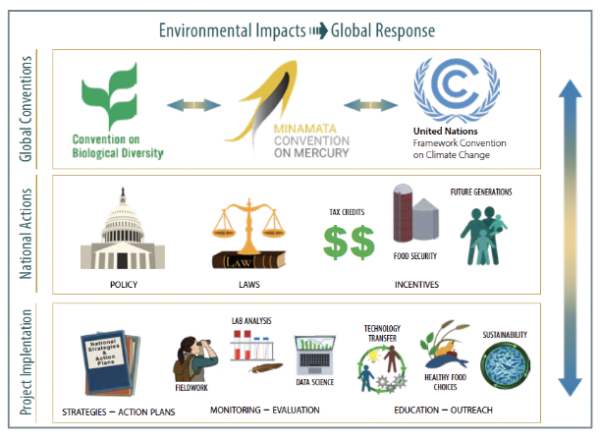 This graphic shows how a coordinated multilevel effort can help mitigate environmental threats.
This graphic shows how a coordinated multilevel effort can help mitigate environmental threats.
 A clear challenge is to better coordinate these global efforts to have greater impact addressing these threats to people and nature. BRI’s scientists are on the front lines of this challenge, working to share our expertise. If these Conventions are successful, global levels of redistributed mercury will decline, carbon emissions will decline, and more carbon emissions will be sequestered. If the reduction of these direct threats to biodiversity is enough, the hope and goal is that global health will be enhanced and the biodiversity crisis can be averted.
A clear challenge is to better coordinate these global efforts to have greater impact addressing these threats to people and nature. BRI’s scientists are on the front lines of this challenge, working to share our expertise. If these Conventions are successful, global levels of redistributed mercury will decline, carbon emissions will decline, and more carbon emissions will be sequestered. If the reduction of these direct threats to biodiversity is enough, the hope and goal is that global health will be enhanced and the biodiversity crisis can be averted.


